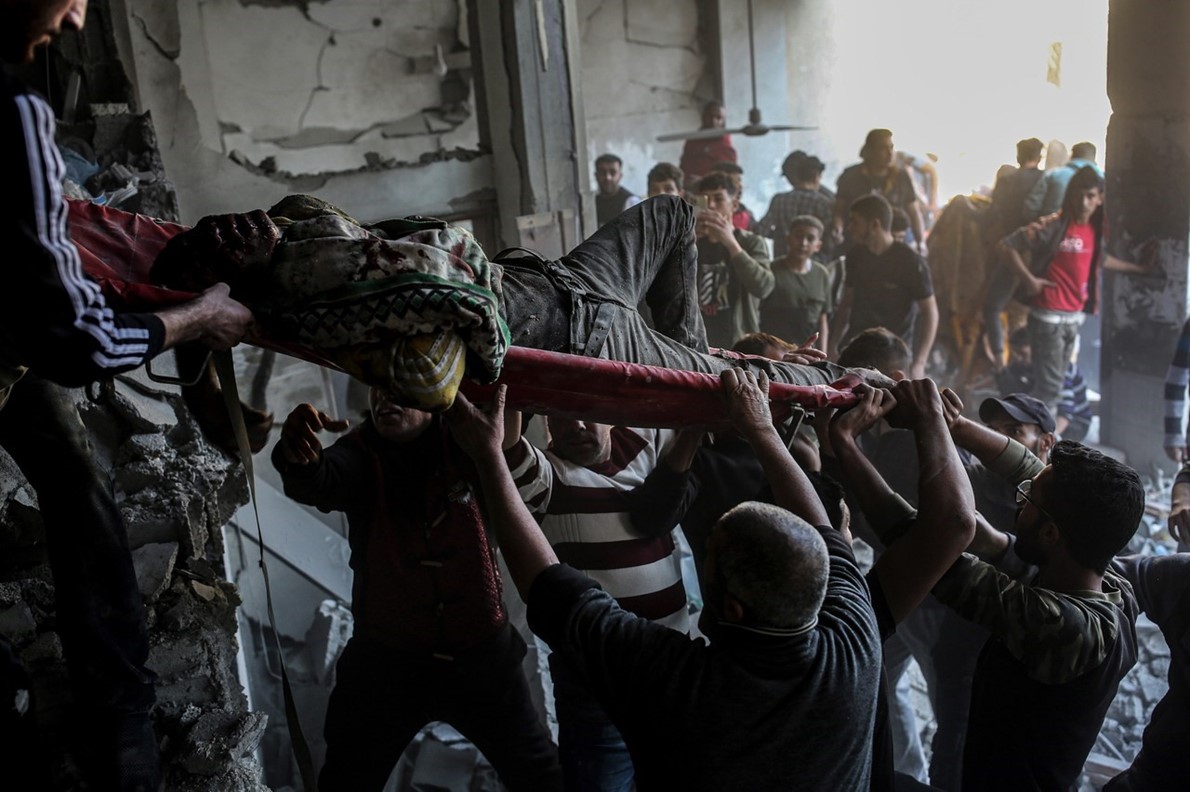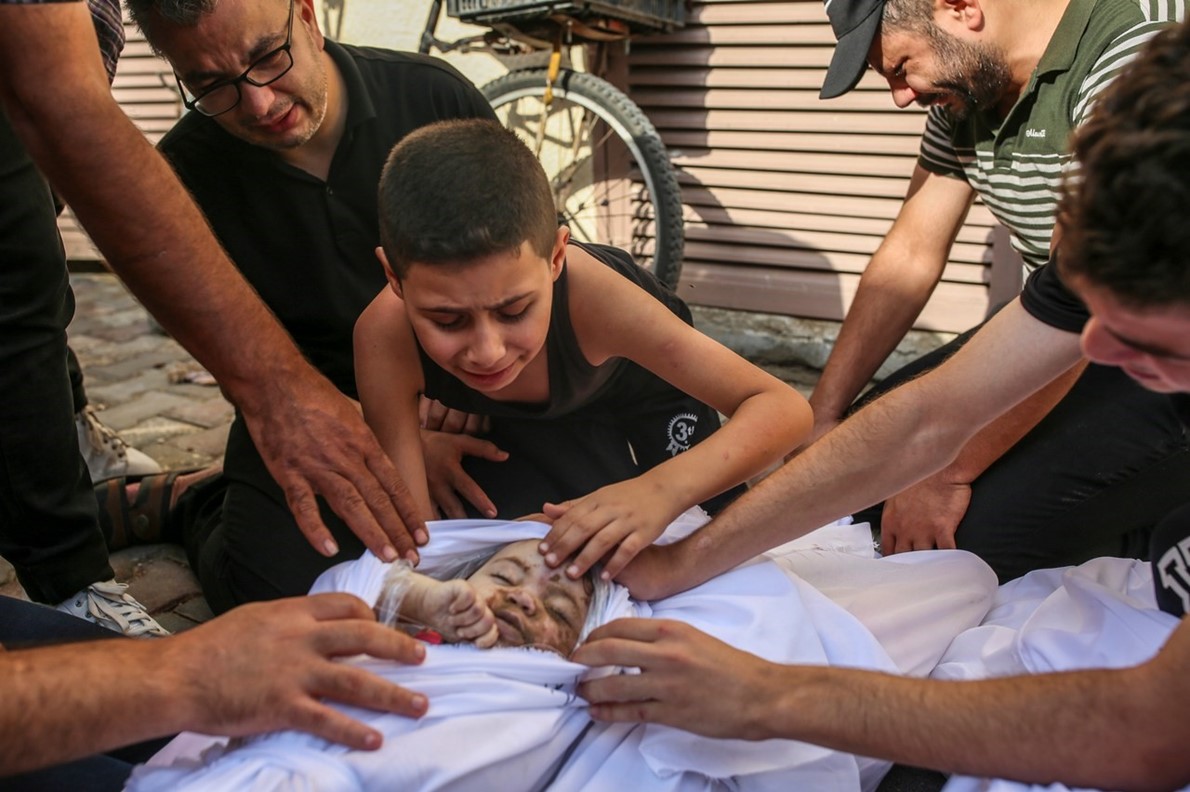For four days, Kareem Sabawi’s body lay
wrapped in a blanket in a cold, empty apartment as his family sheltered nearby.
He was killed during intense Israeli bombardment near his family home, his
father and mother said, and in the days that followed, it was too dangerous to
step outside and lay their 10-year-old child to rest.
اضافة اعلان
His family called the Palestine Red Crescent
for help. But it was the early days of Israel’s ground invasion in the northern
Gaza Strip, and forces were blocking streets with tanks and gunfire, preventing
rescue workers from reaching those killed by Israeli airstrikes. Each day, the
father, Hazem Sabawi, suffered a double torment — mourning his son and unable
to afford him the final dignity of a proper burial.
“After the fourth day, I said that’s it.
Either I will be buried with him, or I won’t bury him at all,” he said,
recounting how he laid his son under a guava tree behind a neighbor’s apartment
building.
Every human has the right to be buried
“Every human has the right to be buried,”
Sabawi said.
Since October 7, the living in Gaza have been
forced to inter their dead hurriedly and without ceremony or last rites, lest
they risk the same fate as their loved ones.
More than 22,000 Palestinians have been killed
by Israel since Oct. 7, according to the Gaza Health Ministry. Civilians are
being killed at a pace with few precedents in this century. The war has turned
Gaza into a “graveyard for thousands of children,” the United Nations said.
“The situation has gotten to the point where
we say: The lucky are those who have someone to bury them when they die,” said
Dr. Mohammad Abu Moussa, a radiologist at Nasser Hospital in southern Gaza.
Traditionally, Palestinians honor their dead
with public funeral processions and mourning tents erected on streets for three
days to receive those who want to offer condolences. But the war has made those
traditions impossible to uphold.
Instead, the dead have been buried in mass
graves, hospital courtyards, and backyard gardens, often without headstones,
their names scrawled on white burial shrouds or body bags. Funeral prayers are
said quickly — if at all — in hospital hallways or outside morgues.
Nebal Farsakh, a spokesperson for the
Palestine Red Crescent, said the violence often made it impossible for rescuers
to reach attack sites or recover bodies. Some families have been trapped inside
their homes for days with the corpses of their loved ones, she said.
Gaza health officials estimate that about
7,000 people in Gaza are missing, most presumed dead under the enormous
destruction from Israel’s onslaught. On some homes, people have spray-painted
the names of those believed to be buried under the rubble.
 Palestinians
in Khan Younis carry the body of a citizen pulled from under the rubble of a
house, in the southern Gaza Strip on Dec. 4, 2023. The dead have been buried in
mass graves, hospital courtyards and backyard gardens, often without
headstones, their names scrawled on white burial shrouds or body bags.
Palestinians
in Khan Younis carry the body of a citizen pulled from under the rubble of a
house, in the southern Gaza Strip on Dec. 4, 2023. The dead have been buried in
mass graves, hospital courtyards and backyard gardens, often without
headstones, their names scrawled on white burial shrouds or body bags.
As nearly 2 million civilians have been
displaced and made dangerous treks on foot to southern Gaza — passing Israeli
forces with guns trained on them — some have described seeing dozens of bodies
along the way, bloated and decomposing. They have told The New York Times that
Israeli soldiers would not allow them to even cover, much less bury, the dead.
The Israeli military said it had prevented
people from approaching bodies “for operational reasons” and also to determine
whether any of the dead might be Israeli hostages taken by Hamas to Gaza on
Oct. 7.
For Sabawi, burying Kareem was the least he
could do for a son he felt he was unable to protect.
He and his wife said an Israeli airstrike hit
near their home in early November when their family was preparing lunch with
what little flour and rations, they had. Sabawi was thrown in the air, and when
he hit the floor, the kitchen door fell on him. When he got up, he saw Kareem
bleeding profusely from his head.
Sabawi said he scooped him up, even though his
arm was injured, and the family ran to a neighbor’s apartment. Kareem was still
breathing as his panicked father administered CPR.
It was too late.
Neighbors took the family in and brought a
blanket to wrap Kareem’s body, Sabawi said. He waited four days, fearing they
might be killed by an airstrike or Israeli soldier if they went outside to bury
him. On the fifth day, Sabawi and a neighbor said the Muslim proclamation of
faith before leaving the apartment.
In the garden behind the building, they dug a
shallow grave and laid Kareem in it, covering him with dirt, and rushed back
inside.
“The next day, I went back down to put more
dirt over the grave,” Sabawi said. On the tree, he hung a makeshift headstone
and placed a brick at the top. “Every time there was an opportunity, I went
down to put more dirt so it would become a proper grave.”
 Bodies lie on the floor
outside Nasser Hospital in Khan Younis, in the southern Gaza Strip on Oct. 17,
2023. Traditionally, Palestinians honor the dead with public funeral
processions and mourning tents erected on the streets for three days to receive
those who want to offer condolences. But the war has made those traditions
impossible to uphold.
Bodies lie on the floor
outside Nasser Hospital in Khan Younis, in the southern Gaza Strip on Oct. 17,
2023. Traditionally, Palestinians honor the dead with public funeral
processions and mourning tents erected on the streets for three days to receive
those who want to offer condolences. But the war has made those traditions
impossible to uphold.
His wife, Suha Sabawi, 32, said she knew that
not all parents in Gaza got the opportunity for such bittersweet closure.
“Lots of people said to me, ‘Thank God you
were able to bury your son,’ because lots of people can’t bury their children,”
she said.
Ahmed Alhattab, a father of four, said a
rocket struck his apartment building on the night of Nov. 7 in Gaza City. There
were 32 family members inside, 19 of them children. Palestinian news media
reported the strike at the time, putting the initial death toll at 10.
Alhattab and three of his sons escaped from
the rubble, but one had a skull fracture and was bleeding. Alhattab handed his
two uninjured sons — ages 5 and 9 — to neighbors and carried his wounded
7-year-old, Yahya until he found an ambulance to take him to a hospital.
The next morning, he said, he returned with
neighbors and relatives, and they dug out four dead family members with their
hands, among them his 32-day-old nephew.
They buried them in a single grave in a
private cemetery that belonged to another family because it was too dangerous
to get to the public cemeteries farther away. Some public cemeteries have also
been razed by Israeli forces.
The rest of his family, 24 relatives, he said,
remained under too much rubble to recover.
For three days, Alhattab said, he stayed at
the hospital as his son underwent surgery. The hospital was nearing collapse as
airstrikes and clashes raged nearby.
He was told his son was unlikely to survive.
As relatives prepared to flee, he said, he
made the heart-wrenching decision to leave Yahya behind to take his other sons
south, where he hoped they would be safer.
Four days later, he heard from a friend that
his son had died in the hospital, where he was buried along with other patients
who died.
“The burial was temporary,” Alhattab said,
“and I don’t know what happened with his body.”
Medical workers have told the Times they have
sometimes had to dig graves in hospital courtyards. When staff members were
forced by the Israeli military to evacuate, they said, they had to leave many
bodies behind.
 Khaled Joudeh searches
for his killed family members, including his baby sister, Misq, at a hospital
morgue in Deir Al-Balah, in the central Gaza Strip, Oct. 22, 2023. Civilians in
Gaza are being killed at a pace with few precedents in this century and the
conflict, the United Nations said, has turned Gaza into a graveyard for
children.
Khaled Joudeh searches
for his killed family members, including his baby sister, Misq, at a hospital
morgue in Deir Al-Balah, in the central Gaza Strip, Oct. 22, 2023. Civilians in
Gaza are being killed at a pace with few precedents in this century and the
conflict, the United Nations said, has turned Gaza into a graveyard for
children.
Now in southern Gaza, Alhattab says he wants
to go home to recover his family’s bodies.
“When we bury the dead, we honor them,” he
said. “And it calms one’s heart a little bit. You know where they are buried.”
When Fatima Alrayess, 35 and living in
Austria, last spoke to her two younger brothers Nov. 8, they told her they were
headed back to their family home in Gaza City.
The brothers — Muhammad, 31, and Muayid, 25 —
told her that a civil defense crew was on its way to the seven-story building,
which had been felled by an Israeli airstrike three days earlier, she said.
They said the attack had killed eight family members, including her parents.
“He wanted to bury them,” she said of Muayid.
But an Israeli siege of Gaza from the early
days of the war had created dire shortages of fuel, among other essential
goods, severely hampering the work of civil defense crews.
That day, the civil defense workers recovered
the bodies of their mother, father and a 12-year-old nephew before it got too
dark, Alrayess and another relative, Lubna Alrayess, learned from the brothers.
The next day, the brothers buried the bodies
of the three family members in a cemetery and met civil defense workers at the
demolished building in hopes of recovering more bodies, Fatima Alrayess said.
Two sisters — one a dentist and the other a banker — a brother and two nephews
were still missing.
As the rescuers began combing through the
rubble, another Israeli airstrike hit, killing both Muayid and Muhammad, as
well as several civil defense workers, according to Fatima Alrayess, her
relative and Palestinian news reports.
The immediate aftermath of the strike was
captured on video by a local photographer, who lamented that the brothers had
followed their parents in death.
“My parents were buried in the afternoon,”
Alrayess said. “Muayid and Muhammad were buried later that night in the same
cemetery.”
Five members of the family remain under the
rubble.
Read more Region and World
Jordan News



